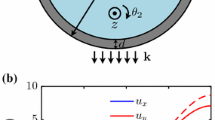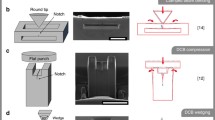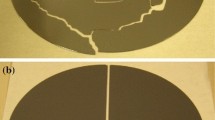Abstract
Fracture toughness of silicon crystals has been investigated using indentation methods, and their surface energies have been calculated by molecular dynamics (MD). In order to determine the most preferential fracture plane at room temperature among the crystallographic planes containing the 〈001〉, 〈110〉 and 〈111〉 directions, a conical indenter was forced into (001), (110) and (111) silicon wafers at room temperature. Dominant {110}, {111} and {110} cracks were introduced from the indents on (001), (011) and (111) wafers, respectively. Fracture occurs most easily along {110}, {111} and {110} planes among the crystallographic planes containing the 〈001〉, 〈011〉 and 〈111〉 directions, respectively. A series of surface energies of those planes were calculated by MD to confirm the orientation dependence of fracture toughness. The surface energy of the {110} plane is the minimum of 1.50 Jm−2 among planes containing the 〈001〉 and 〈111〉 directions, respectively, and that of the {111} plane is the minimum of 1.19 Jm−2 among the planes containing the 〈011〉 direction. Fracture toughness of those planes was also derived from the calculated surface energies. It was shown that the K IC value of the {110} crack plane was the minimum among those for the planes containing the 〈001〉 and 〈111〉 directions, respectively, and that K IC value of the {111} crack plane was the minimum among those for the planes containing the 〈011〉 direction. These results are in good agreement with that obtained conical indentation.
Similar content being viewed by others
References
C.P. Chen M.L. Leipold (1980) ArticleTitleFracture toughness of silicon American Ceramic Society Bulletin 59 469–472
R.F. Cook G.M. Pharr (1990) ArticleTitleDirect observation and analysis of indentation cracking in glasses and ceramics Journal of the American Ceramic Society 73 787–817 Occurrence Handle10.1111/j.1151-2916.1990.tb05119.x
R.W. Davidge (1979) Mechanical Behaviour of Ceramics Cambridge University Press Cambridge 32
F. Ebrahimi L. Kalwani (1999) ArticleTitleFracture anisotropy in silicon single crystal Materials Science Engineering. A 268 116–126 Occurrence Handle10.1016/S0921-5093(99)00077-5
M. Esashi (1996) ArticleTitleSilicon micromachining for integrated microsystems Vacuum 47 469–474 Occurrence Handle10.1016/0042-207X(96)00003-6
M. Fujiwara (2002) ArticleTitleCharacterization of mechanical properties in materials through instrumented indentation Journal of the Japan Institute Light Metals 52 282–290 Occurrence Handle1898144
J.J. Gilman (1960) ArticleTitleDirect measurements of the surface energy of crystals Journal of Applied Physics 31 2208–2218 Occurrence Handle10.1063/1.1735524 Occurrence Handle1960JAP....31.2208G
Gilman J.J. (1920). Fracture, The Technology Press of Massachusetts Institute of Technology. (1959) pp. 202.
A.A. Griffith (1920) ArticleTitleThe phenomena of rupture and flow in solids Philosophical Transactions of the Royal Society of London Series A 221 163–198 Occurrence Handle1921RSPTA.221..163G
K. Hayashi S. Tsujimoto Y. Okamoto T. Nishikawa (1991) ArticleTitleFracture toughness of single crystal silicon Journal of the Society of Material Science Japan 40 405–410
K. Higashida M. Tanaka R. Onodera (2005) Materials Science Forum 475–479 4043–4046 Occurrence Handle10.4028/0-87849-960-1.4043
J.P. Hirth J. Lothe (1992) Theory of Dislocations EditionNumber2 Krieger Publishing Company Malabar Florida 836
A. Kelly N.H. Macmillan (1986) Strong Solids EditionNumber3 Oxford Science Oxford 382
G. Michot (1988) ArticleTitleFundamentals of silicon fracture Crystal Properties & Preparation 17–18 55–98
T. Mizuguchi K. Ikeda F. Yoahida H. Nakashima H. Abe (2004) ArticleTitleEvaluation of crystal orientation dependence of surface energy in silicon Journal of the Japan Institute of Metals 68 86–89 Occurrence Handle10.2320/jinstmet.68.86
E. Orowan (1934) ArticleTitleDie mechanischen Festigkeitseigenschaften und die Realstructur der Kristalle Z. Kristallogr. (A) 89 327–434
J. Samuels S.G. Roberts (1989) ArticleTitleThe brittle-ductile transition in silicon. I. experiments Proceedings of the Royal Society of London A 421 1–23 Occurrence Handle1989RSPSA.421....1S Occurrence Handle10.1098/rspa.1989.0001
M. Tanaka K. Higashida H. Nakashima H. Takagi M. Fujiwara (2003) ArticleTitleFracture toughness evaluated by indentation methods and its relation to surface energy in silicon single crystals Materials Transactions 44 681–684 Occurrence Handle10.2320/matertrans.44.681
J. Tersoff (1989) ArticleTitleModeling solid-state chemistry: interatomic potentials for multicomponent systems Physical Review B 39 5566–5568 Occurrence Handle10.1103/PhysRevB.39.5566 Occurrence Handle1989PhRvB..39.5566T
I. Yonenaga (1996) ArticleTitleUpper yield stress of Si crystals at high temperatures Journal of Electrochemical Society 143 L176–L178 Occurrence Handle10.1149/1.1837021
F. Zwicky (1923) ArticleTitleDie Reiβfestigkeit von Steinsalz Phys. Z 24 131–137
Author information
Authors and Affiliations
Corresponding author
Rights and permissions
About this article
Cite this article
Tanaka, M., Higashida, K., Nakashima, H. et al. Orientation dependence of fracture toughness measured by indentation methods and its relation to surface energy in single crystal silicon. Int J Fract 139, 383–394 (2006). https://doi.org/10.1007/s10704-006-0021-7
Received:
Accepted:
Issue Date:
DOI: https://doi.org/10.1007/s10704-006-0021-7




